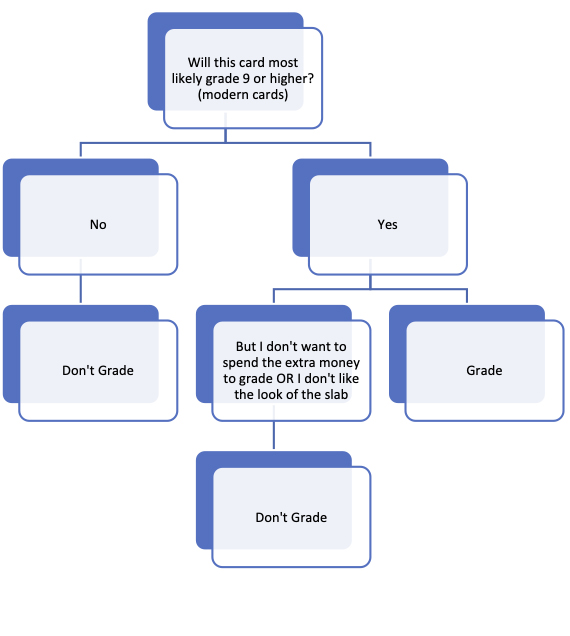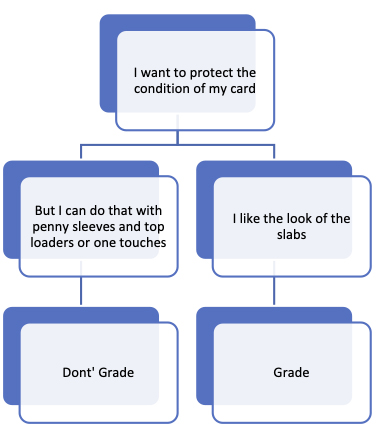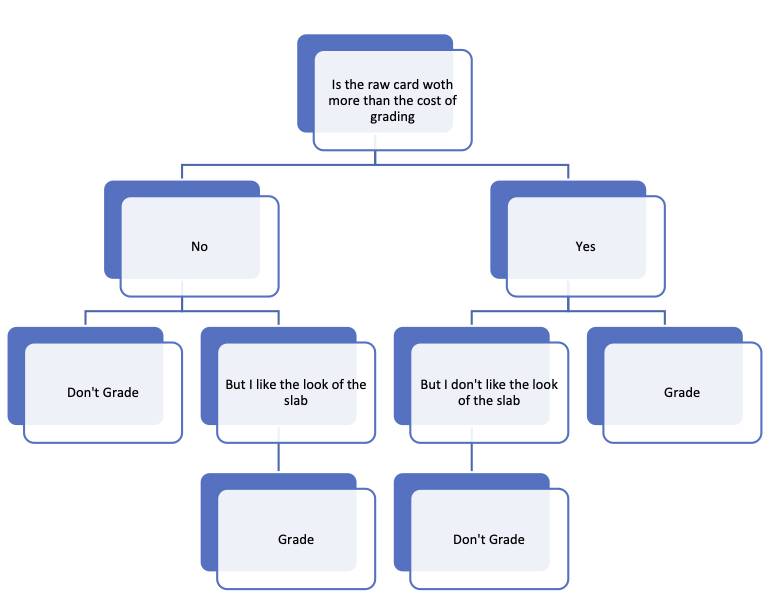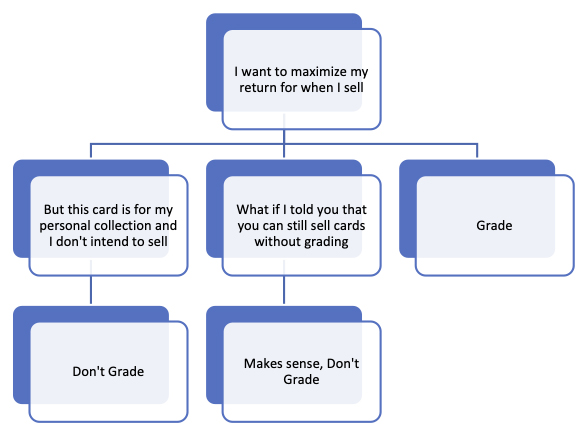Grading cards is a loose way to say authenticating and objectively measuring the cards physical quality. There are many companies out there that will grade cards, this includes authenticating the card and making sure it is real, ranking it on a 1-10 scale for how the quality is reflected on the card, and placing the card in a sealed case to retain the quality.
The quality of a card is based generally on how good of physical condition the card is and how well the card was made. Encapsulating it is placing and sealing the card in a tamperproof proprietary holder/case.
The general idea of grading a card is to give it to a grading company, they will make sure it is real using several tests, then they will inspect it with more than just the human eye (this could be a jewelers loupe, a microscope or digital imaging). Once they have reviewed it, they will assign it a grade. You can grade with companies like PSA, SGC, BGS, BCCG etc.
Then it’s sent back to you nice and protected forever.
You can read more about grading here.
You can learn about pre-assessing your cards before grading here.
Now: Should I get this trading card graded? Let’s answer that.
Will it grade higher than 9? #

I want to protect my card #

Will grading be profitable? #

I want to make maximum return on a sale #

This should help you with your decision on whether you should grade your card or not.
Grading Quick Guide #
What to Grade #
Choosing what cards to grade is a personal and subjective decision. But there are some guidelines to follow that will not only save you money, but also increase the value of your collection. For example, grading any one-of-one card makes little sense from a financial standpoint, although people continue to do so. The cost of having the card shipped, graded, insured and returned is unlikely to increase the worth of an already highly valued card enough to offset those costs. However, some collectors may like the added protection of a graded slab.
Submitting vintage cards for grading, in particular, makes for a solid investment. Player collectors, team collectors and set builders often target cards in a specific grade. Removing the subjectivity of self-assessment provides a foolproof way of making sure a card is actually in the condition the owner claims.
Even vintage commons can bring a strong return if submitted to a reputable card grading company. A mistake many collectors make with older cards is overlooking these commons. Many high-end set builders will often pay top-dollar for that graded NM or Mint backup utility infielder’s card simply to complete their collection of graded cards.
Modern prospect and rookie autographs are also highly desirable in high-grade condition. The obvious reason is that, if that player attains star status, their most popular rookie cards will always be those that are signed and in Mint condition.
Grading Companies #
When it comes to choosing what service to use, it is best to do your research. Ask fellow collectors, dealers and your local hobby shop owner who they use and why.
Currently, there are several reputable and established grading companies in the hobby: Professional Sports Authenticators (PSA), Beckett Grading Services (BGS) and Sportscard Guaranty (SGC). Each card grading company grades a variety of cards.
Fees between the companies vary so collectors are encouraged to see the pricing policies listed on their respective websites. Collectors can also pay for different levels of service.
In addition to the companies mentioned above, the marketplace has seen several other grading companies come and go over the years. Plenty of their cards still exist on the secondary market. These include Global Authenticators International (GAI), Card Collector Services (CCS), and Sports Collectors Digest (SCD), to name a few.
When grading became popular in the early- to mid-’90s, new grading companies sprouted up in unprecedented quantities. Some earned very poor reputations. While smaller, and less well-known companies exist, it is strongly advised that collectors only trust their collection to those first mentioned: PSA, BGS and SCG. Those are the companies with the best reputation in the hobby.
The Cost of Card Grading #
As mentioned earlier, exact fees differ among card grading companies, however they all charge based on the following criteria:
1. The number of cards submitted.
2. The desired turnaround time to have your cards graded and returned.
Other factors that can determine service price are:
– The value of the card.
– Whether a card containing an autograph is to be authenticated as well as graded.
– If the card is an oddball or oddly sized card.
Also, keep in mind that you are required to pay two-way shipping. When sending to the company, pay for the appropriate amount of insurance, delivery and signature confirmation. For return shipping, each company will have their own established fee structure. This usually includes insurance.
It should be noted that each major grading company regularly appears at sports card and memorabilia shows throughout the year. At these events, they often provide onsite submissions and onsite card grading services. This can save a you a lot amount of money on shipping and insurance fees. It also provides the additional security of not releasing your cards into the possession of a third-party parcel carrier.
How to Submit Cards for Grading #
Before you send your cards in to be graded, you may need to pick up the following supplies:
– Penny Sleeves
– Semi-Rigid Card Saver Holders
– Packing Peanuts or Bubble Wrap
– Packing Tape
While the practice may vary in the details from company to company, the basics are the same. They involve completing a submission form and packaging cards to send to the grading facility. Be sure to refer to each company’s specific submission policy prior to starting the process. However, here are general guidelines that apply to all companies.
Once the card grading submission form is completed, prepare your cards for shipping by putting each of them in a penny sleeve and then into a semi-rigid holder like those from the popular Card Saver series. Do not use top-loaders, snap tights or screw-downs. Most grading companies will return cards back to you ungraded if they are sent in this way.
Next, place all of the cards to be submitted in between two pieces of cardboard that are larger than the cards’ holders. This will make sure they don’t bend.
Secure the bundle with rubber bands. Be sure that the rubber bands are not too tight. They should be just tight enough to hold the cardboard pieces together and prevent the cards from falling out. Tight rubber bands could damage your cards.
Prepare the box for shipping by filling it partially with packing peanuts, bubble wrap or newspaper. Nestle the card bundle and fill the remaining portion of the box. Insert the completed submission form and payment. Use non-clear packaging tape to completely wrap the box, not just the box edges. From there, follow the specific submission instructions from the appropriate company. Keep a copy of your card grading submission form for your records.
This is the time to think of any additional services required, such as autograph authentication. Additionally, some card grading companies allow collectors to determine a minimum acceptable grade. For example, a collector may specify that if a card receives a grade lower than an 8, that it not be encapsulated. The collector is still charged the full price for having the card processed, graded and returned.
Some companies offer an actual card grading submission kit that comes with a submission form, fee schedule and materials for packaging your order. This is a great customer service gesture and can save collectors money. Check the company’s website to see if they offer this.
Receiving Your Order #
Once you receive your order, carefully examine it. Cross-reference the contents to the packing slip and the copy of the original submission form. Verify that the cards have been cataloged properly by entering the number into the company’s database to make sure that the grade on the label is connected to your card.
Storage, Archival and Display #
There are several options for storing and displaying your graded cards. The size of an encapsulated graded card requires specially-sized boxes. They vary from simple corrugated cardboard boxes all the way up to elaborate wood and velvet-lined archival boxes.
The choice is personal to taste and budget. However, regardless of what system you use, be sure your graded cards are secure from sliding into each other. The card capsules are prone to scratching. While this does not impact the card’s grade and subsequent value of the card itself, it certainly diminishes its eye appeal.
Display cases that allow you to slide cards into secured trays, display in multiple rows and can be wall-mounted make for an excellent presentation to show off any graded card collection.
